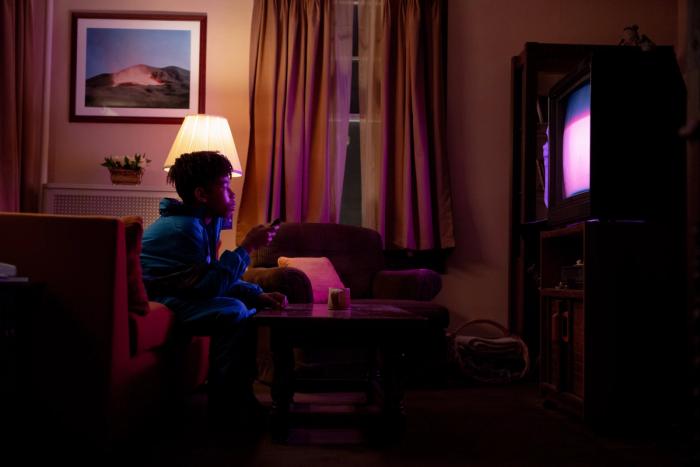The Intrinsic Transness of ‘I Saw the TV Glow’
The film opened last week to rave reviews but has been somewhat divisive. The divide comes from cis- and queer/transgender audiences.
Jane Schoenbrun’s sophomore feature, I Saw the TV Glow, is indubitably a very trans movie. It chronicles the life of Owen (Justice Smith), a shy teenager in the late 90s, and his connection with The Pink Opaque, a TV show that a peer, Maddy (Brigette Lundy-Paine), introduces him to. The film opened last week to rave reviews but has been somewhat divisive. The divide comes from cis- and queer/transgender audiences.
Schoenbrun, who identifies as trans and non-binary, spoke about the film’s resonance with queer audiences and said, “The movie does speak for itself, to a certain degree, to the people who are listening. The fact that certain audiences can watch it and not be able to find that legibility, whereas other audiences can watch and be bawling their eyes out and talk about it surfacing feelings that are deep and visceral ― to me, that almost feels like the thing I’m most proud of.”
This article contains spoilers for I Saw the TV Glow.
“What if I really was someone else, someone beautiful and powerful…but that’s just fantasy, kid stuff.”
The film’s central theme is about self-identity, which is not exclusive to the queer experience, but the way the theme is portrayed in the film is explicitly trans. I Saw the TV Glow is a film that many queer adolescents can resonate with, and one that may leave cis audiences unaffected. In the film, Owen very clearly has gender dysphoria. He speaks in a high, squeaky voice, walks with his shoulders slumped, and his head down, and keeps to himself. It’s something many pre-/non-transition trans people have gone through.
After the self-discovery phase and coming to terms with inner identity, there’s a period that many trans people go through in which they aren’t sure how to craft an external identity for themselves. Either they can’t come out and transition due to societal circumstances or there’s an element of imposter syndrome or any other number of reasons. This film perfectly encapsulates that feeling of trying to fit in when you’re not even sure how you fit into your own skin. It’s not a feeling that the majority of cisgender people are familiar with.

I Saw the TV Glow poses this very real phenomenon that many queer teenagers and young adults experience: projecting their lives onto very niche media. When there’s no meaning to be found in life, it feels good to have something to yourself, to say that you feel seen by this TV show or movie or book or manga because it may have implicitly queer themes.
The film takes this theme further by literally giving Owen the opportunity to become who he really is if he takes the plunge to leave the Midnight Realm, the realm controlled by Mr. Melancholy (Emma Portner), The Pink Opaque’s big bad, and go inside the TV show. And he, unfortunately, lets that chance pass him by multiple times.
I think trans folk are able to resonate with these themes greatly. Many fantasize about some way to turn into a character from the media that brings some euphoria, or to leave a mundane existence and go on the fantastical journey that transition seems like. Schoenbrun illustrated this desire in quite a beautiful way in their film, but it’s something that cis audiences, many of whom are confident and content in their identity, may not be able to relate to.

“The longer you wait, the closer you get to suffocating.”
Another element of the film that may divide cis and trans audiences is its ending. I Saw the TV Glow ends 30 years later as Owen, now old and sickly, has settled down and accepted his false identity. He rediscovers The Pink Opaque on a streaming service and is heartbroken to find that it’s not the same as it was before. The charming, horror TV show he once loved is now a cheesy children’s show.
In the film’s final sequence, Owen has a breakdown at work, goes into the restroom to recuperate, and uses a box cutter to split open his chest. Inside, is the glow of a TV playing The Pink Opaque. He leaves the restroom, apologizes to his coworkers and customers, and the film just…ends. That’s it.
There’s no final act in which Owen acknowledges his dysphoria, comes out, and begins the long journey to transition. No surreal, dream-like sequence in which Owen finally takes the leap of faith to leave the Midnight Realm and enter The Pink Opaque, the REAL Pink Opaque, not the children’s show that Mr. Melancholy created to deceive Owen. That is how the movie ends.

“THERE IS STILL TIME”
It’s an ending that at first glance, felt miserable and left me absolutely devastated. I saw myself in Owen so much and I wanted so badly for him to get his happy ending, just as I, myself, need a happy ending.
Schoenbrun explained why they decided to end the film the way it does, “Anytime I get to an ending that feels tilted too much toward a happy-ending or sad-ending extreme, I start to feel like I’m not doing my job… Transition leaves you traumatized for the rest of your life. Trans people will be unpacking pre-transition for as long as they live, as well as many other things out of their control. If the movie is giving you a feeling at the end of emancipation or transcendence, that’s a lie—and then I start to feel gross as an artist.”
I realize now, it’s not a morbid ending at all. In fact, it’s quite bittersweet. Owen may not have accepted his true identity, but in those final moments, I felt as if Schoenbrun was saying “there is still time”. It’s an ending that I’m sure trans audiences could get behind, but one that may leave some cis viewers feeling alienated.
I Saw the TV Glow felt like a wake-up call as I’m sure it is for many trans people. It’s a cautionary tale to not end up like Owen. It’s hard to imagine that many cis people would be able to relate to this experience. While I Saw the TV Glow may appeal to all with its themes of self-discovery and identity, there is very much a divide in the reception that cis and trans people will have of the movie.

If you liked this article, feel free to check out more of our stuff here at Feature First.













